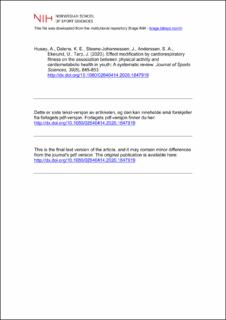| dc.contributor.author | Husøy, Anders | |
| dc.contributor.author | Dalene, Knut Eirik | |
| dc.contributor.author | Steene-Johannessen, Jostein | |
| dc.contributor.author | Anderssen, Sigmund Alfred | |
| dc.contributor.author | Ekelund, Ulf | |
| dc.contributor.author | Tarp, Jakob | |
| dc.date.accessioned | 2021-11-09T08:21:13Z | |
| dc.date.available | 2021-11-09T08:21:13Z | |
| dc.date.created | 2021-01-12T09:13:50Z | |
| dc.date.issued | 2020 | |
| dc.identifier.citation | Journal of Sports Sciences. 2020, 39(8), 845-853. | en_US |
| dc.identifier.issn | 0264-0414 | |
| dc.identifier.uri | https://hdl.handle.net/11250/2828493 | |
| dc.description | I Brage finner du siste tekst-versjon av artikkelen, og den kan inneholde ubetydelige forskjeller fra forlagets pdf-versjon. Forlagets pdf-versjon finner du på www.tandfonline.com / In Brage you'll find the final text version of the article, and it may contain insignificant differences from the journal's pdf version. The original publication is available at www.tandfonline.com | en_US |
| dc.description.abstract | Physical activity and cardiorespiratory fitness are inversely associated with markers of cardiometabolic risk in children and adolescents, but the interplay between these variables in relation to the cardiometabolic risk profile is unclear. We systematically reviewed the literature to examine whether the association between physical activity and cardiometabolic health differs by levels of cardiorespiratory fitness in youth. A literature search was conducted in PubMed and EMBASE, filtered from 2001 up until July 2019. We obtained 8980 citations, with 6915 remaining after removal of duplicates. Estimates were retrieved from 18 studies. All included articles went through a risk of bias assessment. We found that 14 out of 20 (70%) effect-estimates supported stronger associations between physical activity and cardiometabolic health markers among low-fit youth as compared to their high-fit peers. The most consistent findings were observed with biochemical markers and blood pressure as outcomes. However, substantial uncertainty is associated with these findings as most of the included studies (~72%) had a high risk of bias. More than two-thirds of the findings supported greatest benefits of physical activity on cardiometabolic risk markers in youth with low cardiorespiratory fitness, although the clinical importance of this difference is unclear. | en_US |
| dc.language.iso | eng | en_US |
| dc.subject | physical activity | en_US |
| dc.subject | cardiorespiratory fitness | en_US |
| dc.subject | cardiometabolic health | en_US |
| dc.subject | effect modification | en_US |
| dc.subject | youth | en_US |
| dc.title | Effect modification by cardiorespiratory fitness on the association between physical activity and cardiometabolic health in youth: A systematic review | en_US |
| dc.type | Peer reviewed | en_US |
| dc.type | Journal article | en_US |
| dc.description.version | acceptedVersion | en_US |
| dc.source.pagenumber | 9 | en_US |
| dc.source.journal | Journal of Sports Sciences | en_US |
| dc.identifier.doi | 10.1080/02640414.2020.1847919 | |
| dc.identifier.cristin | 1869534 | |
| dc.description.localcode | Institutt for idretsmedisinske fag / Department of Sports Medicine | en_US |
| cristin.ispublished | true | |
| cristin.fulltext | postprint | |
| cristin.qualitycode | 1 | |
